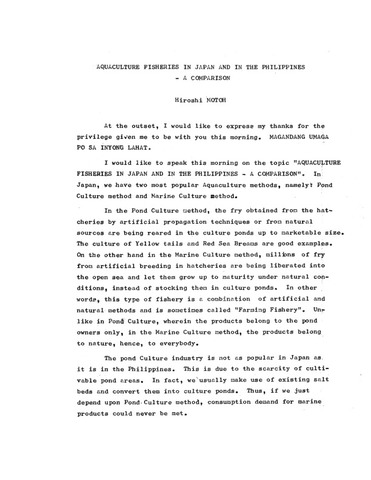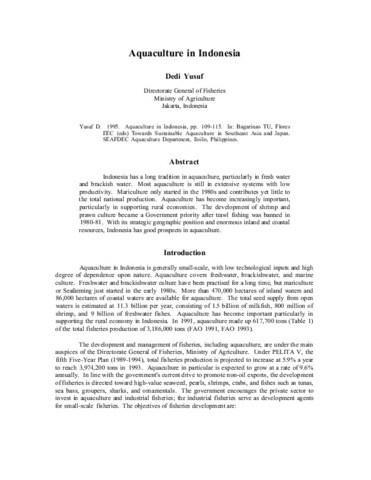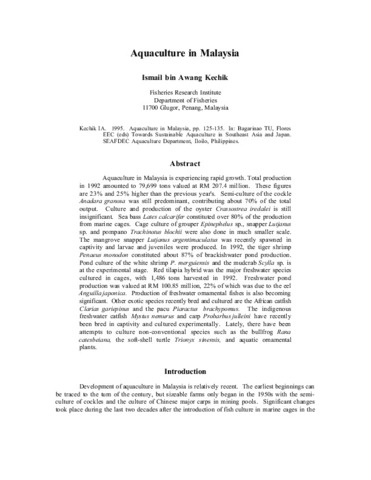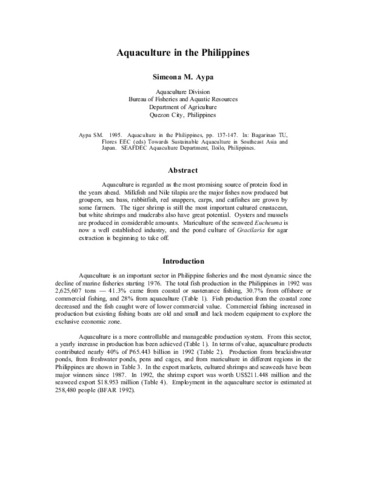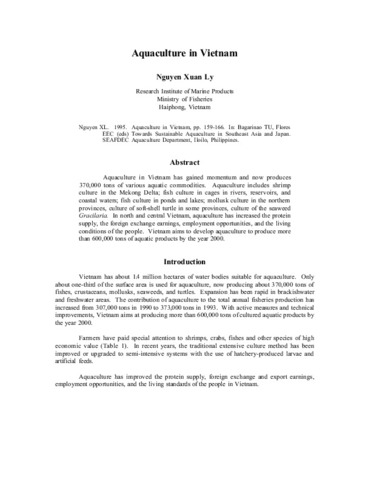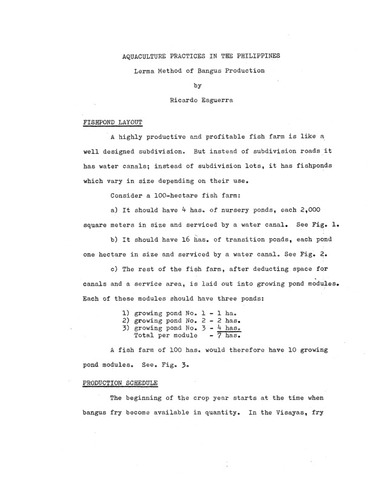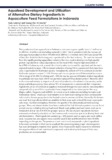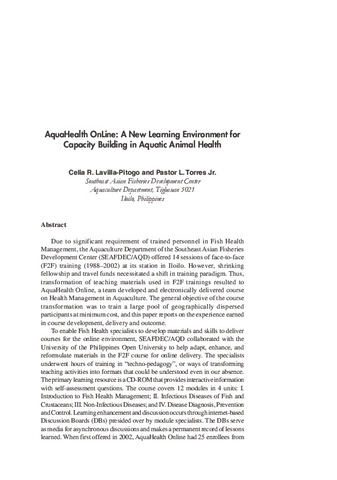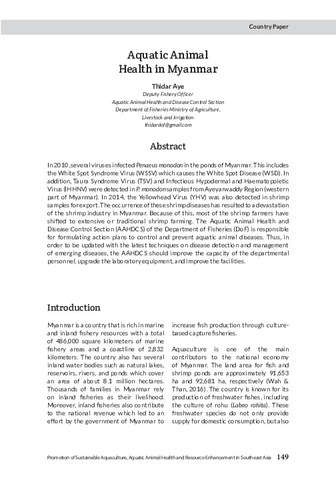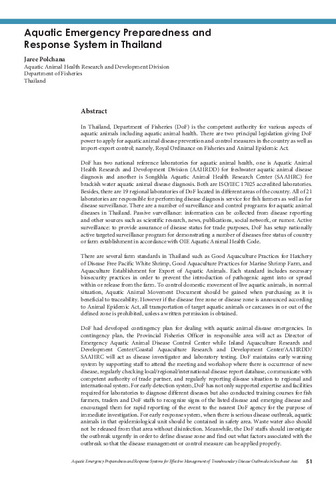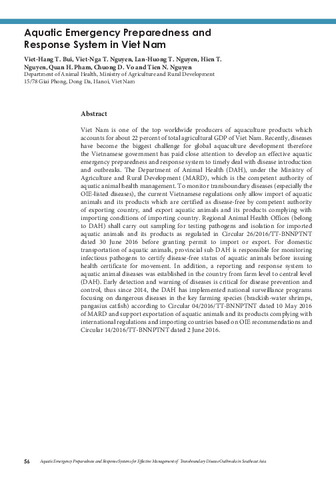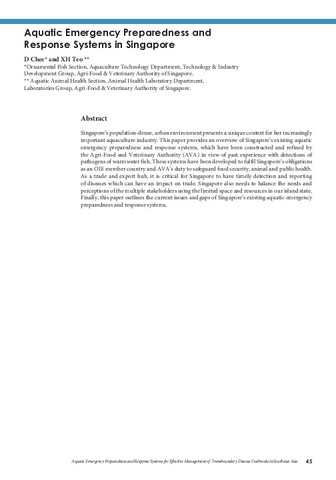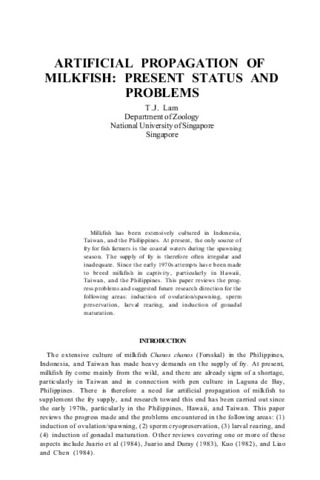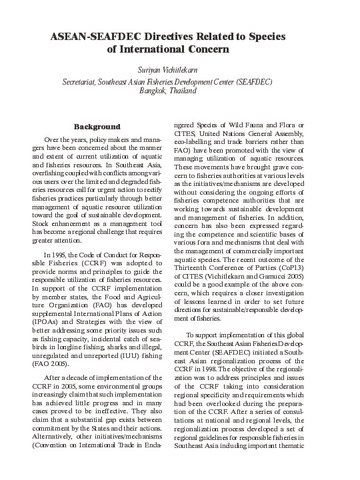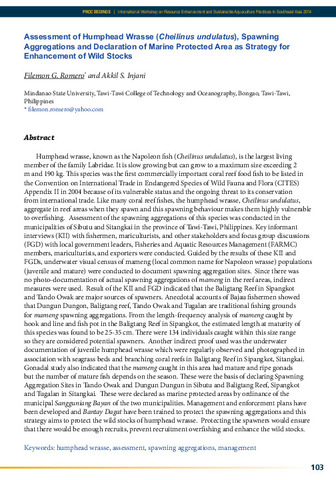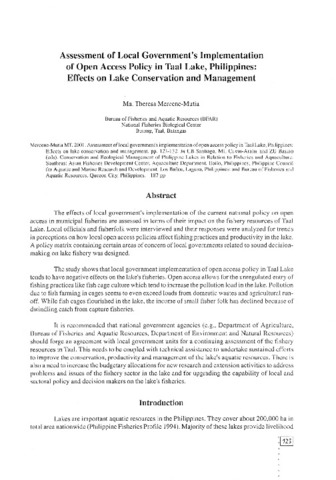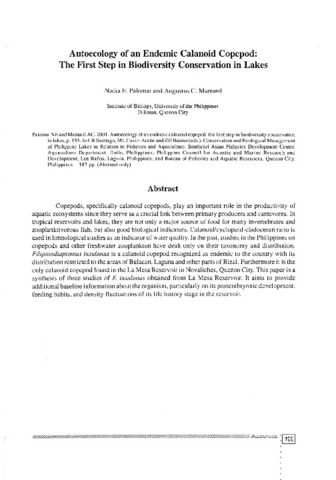Browsing Conference Proceedings by Title
Now showing items 35-54 of 767
-
Aquaculture in Indonesia
(Aquaculture Department, Southeast Asian Fisheries Development Center, 1995)Indonesia has a long tradition in aquaculture, particularly in fresh water and brackish water. Most aquaculture is still in extensive systems with low productivity. Mariculture only started in the 1980s and contributes yet ... -
Aquaculture in Malaysia
(Aquaculture Department, Southeast Asian Fisheries Development Center, 1995)Aquaculture in Malaysia is experiencing rapid growth. Total production in 1992 amounted to 79,699 tons valued at RM 207.4 million. These figures are 23% and 25% higher than the previous year's. Semi-culture of the cockle ... -
Aquaculture in the Philippines
(Aquaculture Department, Southeast Asian Fisheries Development Center, 1995)Aquaculture is regarded as the most promising source of protein food in the years ahead. Milkfish and Nile tilapia are the major fishes now produced but groupers, sea bass, rabbitfish, red snappers, carps, and catfishes ... -
Aquaculture in Vietnam
(Aquaculture Department, Southeast Asian Fisheries Development Center, 1995)Aquaculture in Vietnam has gained momentum and now produces 370,000 tons of various aquatic commodities. Aquaculture includes shrimp culture in the Mekong Delta; fish culture in cages in rivers, reservoirs, and coastal ... -
Aquaculture practices and their impact on Philippine Lakes
(Aquaculture Department, Southeast Asian Fisheries Development Center; Philippine Council for Aquatic and Marine Research and Development (PCAMRD), Department of Science and Technology; Bureau of Fisheries and Aquatic Resources, 2001)The rapid progress and development in the aquaculture sector during the past years has made an important contribution to the overall fish production in the Philippines. In 1996, 35.4% of the total fish production or 980,857 ... -
Aquafeed development and utilization of alternative dietary ingredients in aquaculture feed formulations in Indonesia
(Aquaculture Department, Southeast Asian Fisheries Development Center, 2015)Fish production from aquaculture in Indonesia continues to grow rapidly from 1.7 million mt in 2009 to 4.0 million mt (excluding seaweed) in 2013. This is consistent with the increase of total aqua feed production from ... -
AquaHealth Online: A new learning environment for capacity building in aquatic animal health
(Aquaculture Department, Southeast Asian Fisheries Development Center, 2004)Due to significant requirement of trained personnel in Fish Health Management, the Aquaculture Department of the Southeast Asian Fisheries Development Center (SEAFDEC/AQD) offered 14 sessions of face-to-face (F2F) training ... -
Aquatic animal health in Myanmar
(Aquaculture Department, Southeast Asian Fisheries Development Center, 2021-12)In 2010, several viruses infected Penaeus monodon in the ponds of Myanmar. This includes the White Spot Syndrome Virus (WSSV) which causes the White Spot Disease (WSD). In addition, Taura Syndrome Virus (TSV) and Infectious ... -
Aquatic emergency preparedness and response system in Thailand
(Aquaculture Department, Southeast Asian Fisheries Development Center, 2019)In Thailand, Department of Fisheries (DoF) is the competent authority for various aspects of aquatic animals including aquatic animal health. There are two principal legislation giving DoF power to apply for aquatic animal ... -
Aquatic emergency preparedness and response system in Viet Nam
(Aquaculture Department, Southeast Asian Fisheries Development Center, 2019)Viet Nam is one of the top worldwide producers of aquaculture products which accounts for about 22 percent of total agricultural GDP of Viet Nam. Recently, diseases have become the biggest challenge for global aquaculture ... -
Aquatic emergency preparedness and response systems for effective management of transboundary disease outbreaks in Southeast Asia: Proceedings of ASEAN Regional Technical Consultation, 20-22 August 2018, Centara Grand Central Ladprao, Bangkok, Thailand
(Aquaculture Department, Southeast Asian Fisheries Development Center, 2019) -
Aquatic emergency preparedness and response systems in Singapore
(Aquaculture Department, Southeast Asian Fisheries Development Center, 2019)Singapore s population-dense, urban environment presents a unique context for her increasingly important aquaculture industry. This paper provides an overview of Singapore s existing aquatic emergency preparedness and ... -
Artificial incubation for intensive fry production of Nile tilapia Oreochromis niloticus (L.)
(Aquaculture Department, Southeast Asian Fisheries Development Center, 1996)Two experiments were conducted to evaluate and compare the production, quality, and survival of eggs and the subsequent growth and survival of fry in two small scale production systems: (i) natural incubation (NI), and ... -
Artificial propagation of milkfish: Present status and problems
(Aquaculture Department, Southeast Asian Fisheries Development Center; International Development Research Centre; Island Publishing House, Inc., 1984)Milkfish (Chanos chanos ) has been extensively cultured in Indonesia, Taiwan, and the Philippines. At present, the only source of fry for fish farmers is the coastal waters during the spawning season. The supply of fry is ... -
ASEAN-SEAFDEC directives related to species of international concern
(Aquaculture Department, Southeast Asian Fisheries Development Center, 2006)To achieve sustainable fisheries for food security in the ASEAN region, the Resolution (RES) and Plan of Action (POA) urge the Member Countries to rectify their fisheries practices through improvement of existing fisheries ... -
Assessment of humphead wrasse (Cheilinus undulatus), spawning aggregations and declaration of marine protected area as strategy for enhancement of wild stocks
(Aquaculture Department, Southeast Asian Fisheries Development Center, 2015)Humphead wrasse, known as the Napoleon fish (Cheilinus undulatus), is the largest living member of the family Labridae. It is slow growing but can grow to a maximum size exceeding 2 m and 190 kg. This species was the first ... -
Assessment of local government's implementation of open access policy in Taal Lake, Philippines: Effects on lake conservation and management
(Aquaculture Department, Southeast Asian Fisheries Development Center; Philippine Council for Aquatic and Marine Research and Development (PCAMRD), Department of Science and Technology; Bureau of Fisheries and Aquatic Resources, 2001)The effects of local government's implementation of the current national policy on open access in municipal fisheries are assessed in terms of their impact on the fishery resources of Taal Lake. Local officials and fisherfolk ... -
Autoecology of an endemic calanoid copepod: The first step in biodiversity conservation in Lakes
(Aquaculture Department, Southeast Asian Fisheries Development Center; Philippine Council for Aquatic and Marine Research and Development (PCAMRD), Department of Science and Technology; Bureau of Fisheries and Aquatic Resources, 2001)Copepods, specifically calanoid copepods, play an important role in the productivity of aquatic ecosystems since they serve as a crucial link between primary producers and carnivores. In tropical reservoirs and lakes, they ...

